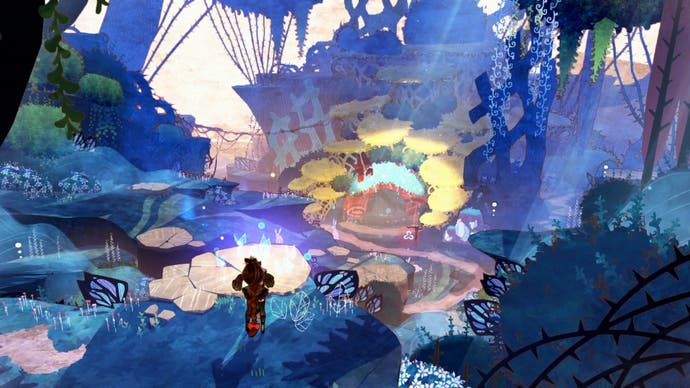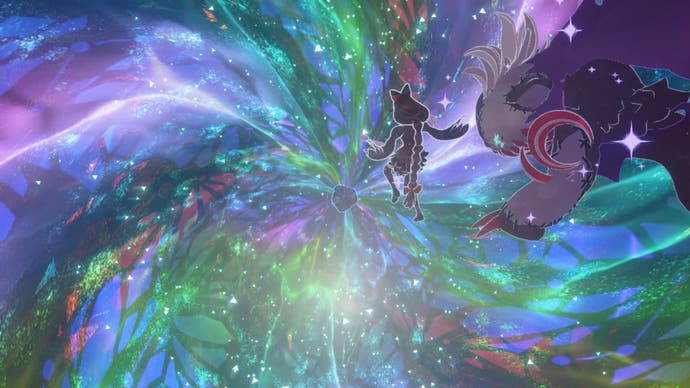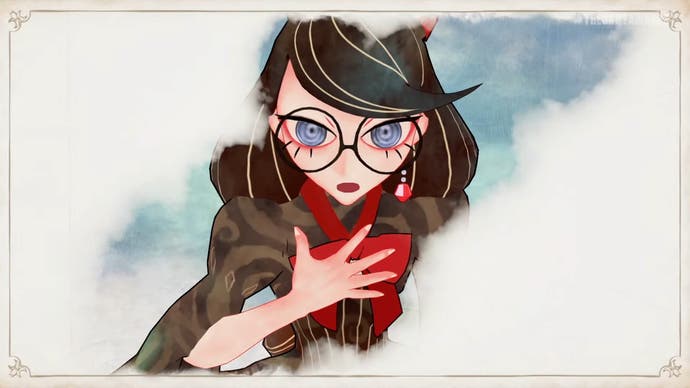Bayonetta Origins: Cereza and the Lost Demon review - luxurious art and ingenious controls await
The first witch.
Better even than starting a game with no expectations, can be starting a game with the wrong expectations. When I first heard about Bayonetta Origins: Cereza and the Lost Demon, I clocked the child protagonist, the hand-drawn illustrative art and the flutter of parchment, and I assumed the whole thing was a sort of visual novel. Sure enough, Cereza kicks off with a lot of story and a lot of reading, with just a few moments of moving a 3D character around in between chunks of text.
But then I found myself in my first battle and thought: Hmm. Maybe I'm not right about this. I was not right about this. Cereza is, all told, a sort of exploration, combat, puzzle game. It's hard enough to define even before you get to its relationship with Platinum's Bayonetta action games. Crucial thing, though: it's lovely. It's lovely and generous and playful and extremely beautiful. Someone took real care here, and that's obvious from the start, whatever misconceptions a person might approach with.
Let's start with the Bayonetta business, actually. This is the story of an apprentice witch and her stuffed cat toy. The witch will one day become Bayonetta but for now she is young, inexperienced, timid and setting out on an adventure that towers over her on all sides. While there's a lot of combat here, it's a very, very different game to the main Bayonetta adventures. It's much slower, even in combat, and it's more concerned with mixing fights up with different bits of business that vary the pace than chaining one battle after the next. Towards the second half of the game - and in the boss fights sprinkled throughout - you get that Platinum excess. But you only get this stuff in bursts.
For a lot of the game you're exploring a mystical forest, solving traversal puzzles and battling tricksy faeries. The hook is that you control Cereza with the left Joy-Con, and her cat Cheshire with the right. Cereza can cast a few spells, most notably a binding move that locks enemies down tight for a while, but most of the battling is handled by Cheshire, who can grow in size to the point where he's a bit of a beast, and has a lovely range of swipe and crush attacks, even before the story gets going and you start to collect new powers.
Cheshire's designed around combat, and there's a lovely mixture of offense and defense as you deal damage with the right hand and build combos, while using the left to keep Cereza out of danger, and, hopefully, manage to work in a few bind-based assists along the way. As the game progressed I started to really look forward to the battles, not just because of the surprising ferociousness of the animations, but because of the ways that different enemies require different approaches. Binding shield guys, plucking floating guys out of the air, and defusing all kinds of magical protection all play a role, and every few levels a new enemy type bursts out of the ground or drops down from the trees and gives you something new to think about.


But Cereza and Cheshire work together in puzzles too. Cereza can hold Cheshire, in a so-called hug mode, which makes navigating a bit easier, and then there are a growing range of moves they can pull off together and separately. The game likes splitting them up, but for the most part they stay pretty close together, Cereza exploring one path, Cheshire another, while puzzles encourage them to work back and forth pulling things, breaking things, flicking switches and the like to let them both progress.
Puzzles are entertaining and interactive but rarely properly brainteasy, and for most of the game they involve working out the stages required to open a path forward. Cereza throws Cheshire up to a ledge they couldn't reach by themselves, and they can then smash through some thorns to access another level. The growing suite of powers come in here in intriguing ways: Cheshire's plant form can pull parts of the environment about, while their stone form can smash down rock walls, for example. Working with Cereza, it's lovely to see how many different challenges a few simple ideas can create when combined in new ways. Crucially, I am the sort of person who has never been able to tell their left from their right, and Cereza's unusual control scheme didn't mix me up too badly.
There's a lot of other stuff here. There's an upgrade system you can access from sanctuary save spots, there are Zelda-style combat and puzzle dungeonettes based around the faeries, and sequences where the world you think you're exploring is not to be entirely trusted. There are potions to craft, resources to gather, and plenty of lovely little story moments. Tons of the game is optional, too: by the time I had completed the main campaign I was still in the 60 percent completion range.

All of this tells you that Cereza has lots of stuff for you to do, but what really astonished me was how beautiful it all looks, and how much that kept me moving forward. Cereza's world in the game is a haunted, spellbound forest, and levels, while linear, never appear so, forming curlicues, creeper-paths, grottoes and glades. Shrubbery hides collectables but also rustles beautifully as you pass, while later levels introduce faery architecture in all its rusty, complicated awkwardness. There are pools here, shielded by the sun by thick canopies of leaves, that feel properly magical, and brilliantly, none of it is photorealistic, opting for the watercolour and mixed media feel of Mary Blair.
A friend was telling me recently about Metroid Dread and why it felt disappointingly 2D, not because it all took place on a single plane, but because it had forgotten to use the foreground as well as the background to create depth. I thought of that while playing Cereza often, because every few minutes a path takes you away from the hovering camera and beneath the curling branches of a tree where animated owls stand and watch, or through a network of swaying grass that temporarily obscures your view. It's this stuff, as much as the range of things to engage with and the hectic action of the game's second half, that makes Cereza feel so luxurious, I think. There is care here, rising off the page, like a story emerging from the opened pages of a children's book and drawing you in.




